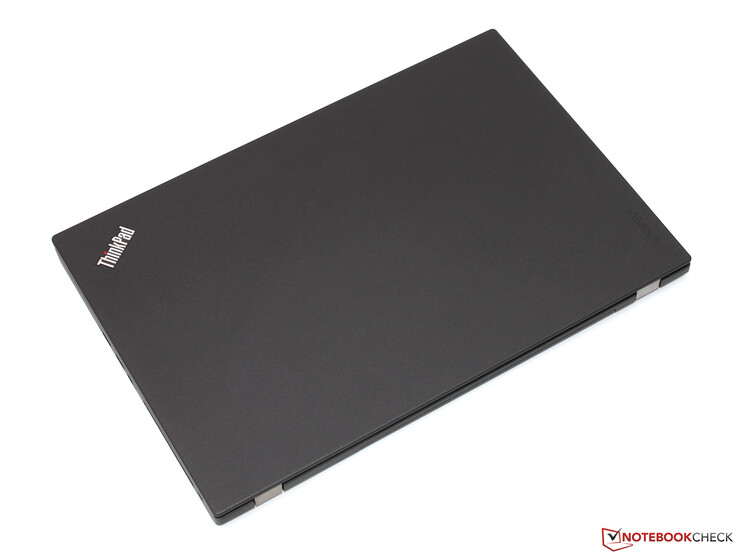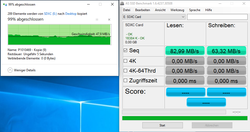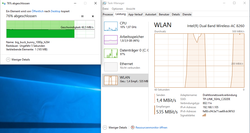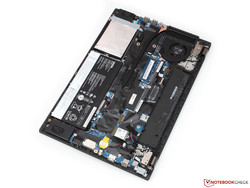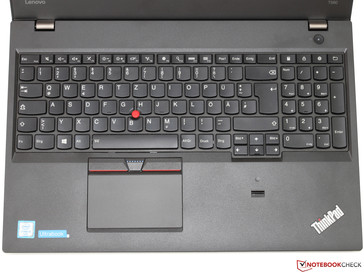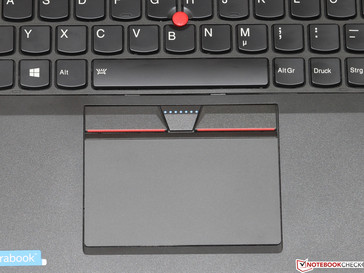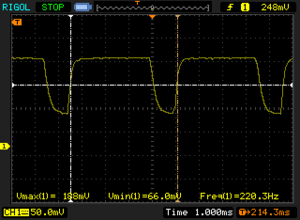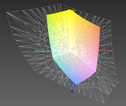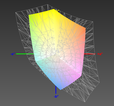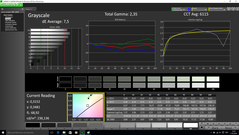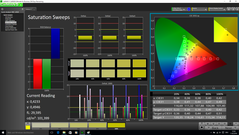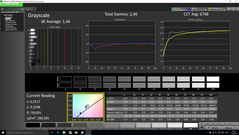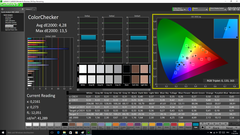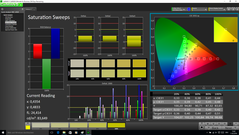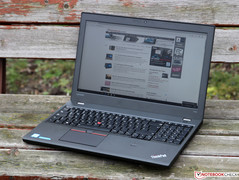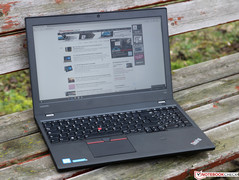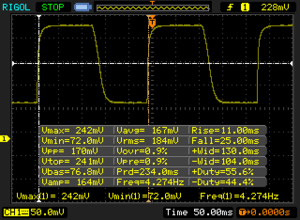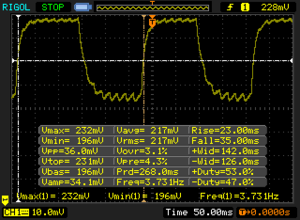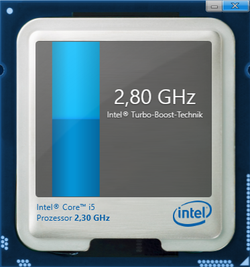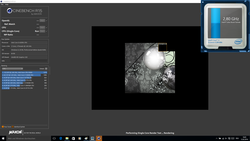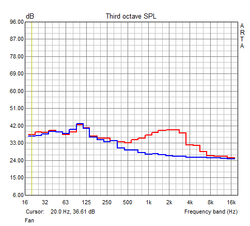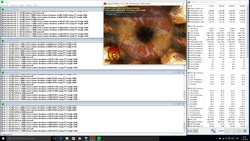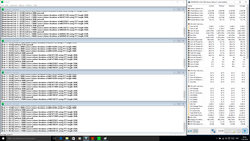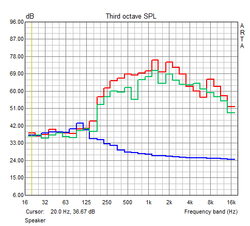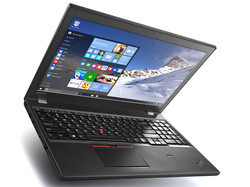Lenovo ThinkPad T560 (Core i5, SSHD) Ultrabook Review

For the original German review, see here.
About five months after the official launch of Skylake, the long-awaited update of Lenovo's business series is coming. As one of the first models, the ThinkPad T560 follows in the footsteps of its T550 predecessor – with new and efficient hardware, a new IPS display, and many modifications in case and connectivity.
Our rather basic test model (Core i5-6200U, 4 GB RAM, 500 GB SSHD, Full HD display) is priced at around 1,400 Euros (~$1539), which supports the premium claim of the T560. It competes with the EliteBook 800-series from HP (review of the 850 G3 shortly) or the Fujitsu Lifebook E756. There are even configurations for more than 3,000 Euros (~$3300) – and wealthy customers will get a real high-end device (Core i7-6600U, 32 GB RAM, 512 GB SSD, 3K display, LTE) that leaves nothing to be desired. Personalized configurations are possible in Lenovo's online shop, but retailers also offer preconfigured models that are usually a bit less expensive.
Case
At least the basic design of the T560 did not change compared to the T550: It is still dominated by an edgy shape and matte-gray plastics, so the 15-inch notebook almost looks a bit outdated. However, this is obviously a matter of taste – much more important are the objective qualities, and the chassis is pretty good in this respect. What looks like cheap plastics at first turns out to be fiberglass reinforced composite that ensures a flawless stability, despite its low weight. Torsion resistance and resistance against concentrated pressure can actually keep up with a metal construction and the roughened surface turns out to be scratch-resistant and does not attract dirt or fingerprints.
Contrary to the base unit, it is no problem to bend the display by a couple of millimeters with medium pressure, which also results in picture distortions – an unattractive, but rather cosmetic issue without effects on the durability. Great as usual are the massive metal hinges that keep the display in position well even with strong vibrations. You should, however, open the lid slowly; otherwise you will also lift the base unit.
Our test model is certainly not as appealing as a unibody construction of the MacBook, for instance, but Lenovo's T560 is a very well-built device without noteworthy issues. Some gaps could be smaller (around the keyboard, for example), but this is criticism on a very high level.
Connectivity
While the VGA port has been dead (for the most part) in the consumer space for a couple of years now, many business notebooks were still equipped with one. Lenovo now waived this old port as well and equipped the T560 with a modern and digital HDMI port instead. Skylake does unfortunately only support HDMI 1.4b and not the current HDMI 2.0 standard, so 4K panels can only be driven at 30 Hz. The ThinkPad fortunately also comes with a Mini-DisplayPort in version 1.2, which allows 3840x2160 pixels at 60 Hz.
The other ports are limited to 3x USB 3.0, Gigabit-Ethernet, an SD-card reader as well as the mandatory headset port distributed across both sides of the chassis. This means the T560 should be well equipped for typical usage scenarios, but we would have liked to see a USB 3.1 port with the new Type-C connector. Maybe this port will be available at an upcoming docking station – current models like the ThinkPad Pro Dock (3x USB 3.0, 3x USB 2.0, 1x VGA, 1x DVI, 1x DisplayPort, 1x LAN, 1x sound) for around 140 Euros (~$154) do not offer it.
Communication
Intel launched a new Wi-Fi module with the designation Wireless-AC 8260 right before the launch of the new Skylake generation, which replaces the old model Wireless-AC 7265. Even though there are no big differences (802.11a/b/g/n/ac, 2x2 TX/RX, 2.4 and 5 GHz) except for the improved Bluetooth support (version 4.2 instead of 4.0), the new adaptor seems to be even faster than before and managed an impressive transfer rate of 60.5 MB/s at a short distance to our TP-Link Archer C7. For comparison: Intel's Wireless-AC managed up to 45 MB/s in our environment – and even the current record holder MacBook Pro 13/15 with a triple-stream adapter is not much faster at 65 MB/s. Range and signal quality are also very good.
Just like the predecessor, the T560 can be equipped with an optional LTE module. This upgrade can also be performed by the user; the necessary antennas are already included ex-works.
The T560 is equipped with a simple 720p webcam and a dual-array microphone for video chats. While the picture quality is typically mediocre for a notebook with low sharpness, washed-out colors and visible picture noise, you do not really need an external headset thanks to the clear and well-understandable voice recordings.
Security
The ThinkPad does not leave anything to be desired in respect of security features and includes, among others, a swipe-style fingerprint scanner, Kensington Lock, TPM (TCG 1.2) as well as (optional) vPro support. It is also possible to set passwords (boot, hard drive, BIOS) to prevent potential data thefts.
Accessories
Except for the short quick-start guide as well as the corresponding 45-watt power adapter, Lenovo does not ship the T560 with any accessories. We still did not miss anything – if necessary – driver and system applications can easily be downloaded from Lenovo's website. Considering the clean Windows 7 installation, we do not really see a reason to perform a clean install right after the purchase; we just decided to make use of the free Windows 10 Pro upgrade for our review.Maintenance
The ThinkPad unfortunately lacks a dedicated maintenance hatch, so all upgrade and maintenance works require a disassembly of the chassis. First, you have to loosen all screws at the bottom before you can lift the whole bottom cover. The latter is secured by numerous small plastic clips, so we would not recommend this procedure for inexperienced users.
Once you have passed this obstacle, the T560 turns out to be very maintenance-friendly. The main battery inside the chassis is only screwed and therefore easy to replace, fan and cooling unit are just as easily accessible as the two memory slots (one of them free), the Wi-Fi module (M.2 2230) as well as the 2.5-inch tray (7 mm high). It is doubtful that the mentioned slot for the WWAN card can also be used for an M.2-SSD since there is no information in Lenovo's spec sheets.
Warranty
You expect quality if you get a real ThinkPad – Lenovo grants a three-year manufacturer's warranty including on-site service, which is usual for this class of devices. This period can even be extended to 4 or 5 years for around 75/150 Euros (~$83/$165), respectively; a fair price when you consider the retail price and that the upgrade could pay off in the future.
Input Devices
Keyboard
A great keyboard is synonymous with the ThinkPad-series for years now. Even though Lenovo updated some details in the meantime (like the switch to a chiclet design a couple of years ago), the keyboard still offers a lot of its original appeal. It is mainly the rich and mechanical stroke that makes the T560 distinctive compared to the rivals. This obviously does not mean that some users might still prefer the keyboard of an HP EliteBook or Dell Latitude – but you will hardly find a better alternative if you are looking for long travel as well as a firm pressure point. We cannot find any quality issues, either: The plastics used leave a sophisticated impression, inputs are executed even at the edges without problems and a two-stage LED illumination ensures perfect visibility.
Touchpad
After the introduction of the so-called 5-button ClickPad, there was a lot of criticism for the 2014 generation of ThinkPads, so Lenovo was forced to revise its decision, at least partly. Since then, the TrackPoint once again has dedicated mouse buttons, but they can also be used in combination with the touchpad. You can decide for yourself what version you use: While the integrated touchpad buttons have a pretty firm and crisp pressure point, the TrackPoint buttons are very quiet and soft. Drag'n'Drop commands are executed reliably with both methods.
Even though the traditional TrackPoint enables a precise and fast navigation, we would recommend the 10 x 5.6 centimeter (3.9 x 2.2 in) touchpad to control the cursor. Thanks to the good gliding capabilities of the surface and the sensitive multi-touch gestures, we hardly missed an external mouse during our review.
Display
Potential buyers of the T560 can decide between a total of four different 15.6-inch displays, starting with a simple WXGA panel (1366x768 pixels, TN panel, 220 cd/m², 400:1), Full HD (1920x1080 pixels, IPS panel, 250 cd/m², 600:1, touch optional) all the way up to a high-end 3K screen (2880x1620 pixels, IPS panel, 350 cd/m², 1000:1). Our Full HD screen does offer a great contrast ratio of 900:1, but clearly misses the advertised maximum luminance. We can only measure 220 cd/m² on average. This should still be sufficient for the office, but we would have liked to see a brighter panel for outdoor usage – but more on that later. Unfortunate: The LED backlight is controlled by PWM under 50% of the maximum luminance, so there can be slight flickering (220 Hz) for sensitive users.
The Full HD resolution with a pixel density of 141 PPI is a good compromise between size, screen estate, price and power efficiency. Even though the picture quality of the 3K panel is appealing, the additional charge of 200 Euros (~$220) is hardly reasonable; the battery runtimes should also be significantly shorter at the same luminance.
Screen Flickering / PWM (Pulse-Width Modulation)
| Screen flickering / PWM detected | 220 Hz | ≤ 50 % brightness setting | |
The display backlight flickers at 220 Hz (worst case, e.g., utilizing PWM) Flickering detected at a brightness setting of 50 % and below. There should be no flickering or PWM above this brightness setting. The frequency of 220 Hz is relatively low, so sensitive users will likely notice flickering and experience eyestrain at the stated brightness setting and below. In comparison: 53 % of all tested devices do not use PWM to dim the display. If PWM was detected, an average of 8170 (minimum: 5 - maximum: 343500) Hz was measured. | |||
| |||||||||||||||||||||||||
Brightness Distribution: 84 %
Center on Battery: 241 cd/m²
Contrast: 900:1 (Black: 0.27 cd/m²)
ΔE ColorChecker Calman: 7.49 | ∀{0.5-29.43 Ø4.79}
ΔE Greyscale Calman: 7.5 | ∀{0.09-98 Ø5}
60.9% sRGB (Argyll 1.6.3 3D)
38.9% AdobeRGB 1998 (Argyll 1.6.3 3D)
42.36% AdobeRGB 1998 (Argyll 3D)
61.3% sRGB (Argyll 3D)
40.96% Display P3 (Argyll 3D)
Gamma: 2.35
CCT: 6115 K
| Lenovo ThinkPad T560-20FH001FGE HD Graphics 520, 6200U, Seagate ST500LM000 Solid State Hybrid Drive | Lenovo ThinkPad T550 HD Graphics 5500, 5600U, Samsung SSD PM851 256 GB MZ7TE256HMHP | Lenovo ThinkPad T540p-20BE005YGE GeForce GT 730M, 4700MQ, Samsung SSD 840 250GB MZ7TD256HAFV | Lenovo ThinkPad P50 Quadro M2000M, 6820HQ, Samsung SSD PM871 MZNLN256HCHP | |
|---|---|---|---|---|
| Screen | -32% | 3% | 9% | |
| Brightness middle (cd/m²) | 243 | 297 22% | 333 37% | 263 8% |
| Brightness (cd/m²) | 220 | 287 30% | 310 41% | 236 7% |
| Brightness Distribution (%) | 84 | 83 -1% | 82 -2% | 78 -7% |
| Black Level * (cd/m²) | 0.27 | 0.9 -233% | 0.62 -130% | 0.34 -26% |
| Contrast (:1) | 900 | 330 -63% | 537 -40% | 774 -14% |
| Colorchecker dE 2000 * | 7.49 | 8.74 -17% | 4.67 38% | 2.35 69% |
| Colorchecker dE 2000 max. * | 15.13 | |||
| Greyscale dE 2000 * | 7.5 | 9.31 -24% | 5.66 25% | 3.33 56% |
| Gamma | 2.35 94% | 2.42 91% | 2.46 89% | 2.38 92% |
| CCT | 6115 106% | 10649 61% | 5966 109% | 6917 94% |
| Color Space (Percent of AdobeRGB 1998) (%) | 38.9 | 50.8 31% | 61 57% | 37 -5% |
| Color Space (Percent of sRGB) (%) | 60.9 | 58 -5% |
* ... smaller is better
With average DeltaE deviations of 7.5 for both the colors and the grayscale, the T560 is hardly better than many consumer notebooks ex-works. While the grayscale performance can be improved significantly by a calibration (DeltaE 1.5), the colors still clearly miss the ideal range (DeltaE 4.3) even with our optimized ICC profile. The low colorspace coverage in particular prevents a better result, because the panel only covers 60.9% sRGB and 38.9% AdobeRGB. The ThinkPad is still suited for editing of holiday pictures, but certainly not for professional graphics or picture editing.
Even though the luminance is not reduced on battery power and the display has no big problems with reflections (anti-glare), the notebook does not work very well outdoors under direct sunlight. Instead of 220, this would require at least 300 cd/m² or more – we would recommend a more compact ThinkPad like the T460s or X260 considering the dimensions and the weight anyway.
Outdoor use (overcast)
The switch from the TN (T550) to the IPS technology does not only provide higher contrast for the T560, but also much wider viewing angles. You can still see the picture contents even from almost 90-degree angles, even though the contrast and the color saturation will drop. Very high-quality displays, like the one from the MacBook Pro 15, for example, are even better in this regard – but this is once again complaining on a very high level.
Display Response Times
| ↔ Response Time Black to White | ||
|---|---|---|
| 36 ms ... rise ↗ and fall ↘ combined | ↗ 11 ms rise | |
| ↘ 25 ms fall | ||
| The screen shows slow response rates in our tests and will be unsatisfactory for gamers. In comparison, all tested devices range from 0.1 (minimum) to 240 (maximum) ms. » 93 % of all devices are better. This means that the measured response time is worse than the average of all tested devices (20.3 ms). | ||
| ↔ Response Time 50% Grey to 80% Grey | ||
| 58 ms ... rise ↗ and fall ↘ combined | ↗ 23 ms rise | |
| ↘ 35 ms fall | ||
| The screen shows slow response rates in our tests and will be unsatisfactory for gamers. In comparison, all tested devices range from 0.165 (minimum) to 636 (maximum) ms. » 94 % of all devices are better. This means that the measured response time is worse than the average of all tested devices (31.7 ms). | ||
Performance
Like all the other T560 models, our review unit is equipped with a dual-core chip from Intel’s Skylake generation, in this case the Core i5-6200U. The mainstream model runs at 2.3-2.8 GHz (2 cores: up to 2.7 GHz) and can execute up to 4 threads simultaneously thanks to Hyperthreading. It is manufactured in an advanced 14 nm process and Intel specifies the TDP of the ULV chip with just 15 watts – this promises long battery runtimes as well as low emissions (noise and heat).
Designed as a business notebook, the T560 usually does not require a lot of graphics performance and just uses the integrated HD Graphics 520 (GT2 with 24 EUs, 300-1000 MHz). If this is not sufficient, you should wait a couple of weeks: According to the spec sheet, the ThinkPad should also become available with the still not officially announced GeForce 940MX, which should provide roughly twice the 3D performance based on our estimates.
The other components of our configuration are 4 GB RAM as well as a 500 GB SSHD, which is the least powerful configuration you can get. Interesting: Contrary to the X260 or T460p, the T560 is not equipped with modern DDR4 memory, but common DDR3L-1600. The appeal of DDR4 memory besides the higher bandwidth (which mainly helps the integrated graphics unit) is primarily the lower power consumption (1.2 instead of 1.35 V supply voltage) as well as the maximum amount of storage: 16 GB modules of DDR4 memory are already available for around 75 Euros (~$83), whereas a comparable DDR3L module is almost twice as expensive.
Processor
Thanks to several architectural improvements, Skylake surpasses its Broadwell predecessor by around 5% at an identical clock, and up to 10% in some applications. If the Turbo Boost of the Core i5-6200U is fully utilized like in this case, the CPU is on par with the former high-end chip Core i7-5500U and even consumes slightly less power (TDP is not fully used even during multithreading). The full CPU performance is available on mains and battery power.
So is it worth it to pay the additional charge for the Skylake i7 CPUs? Not really in our opinion: Despite the larger L3 cache and higher clocks, the Core i7-6500U is only around 10%, the i7-6600U only around 15% faster than the i5-6200U. The differences are not perceptible in practice – but definitely in your wallet.
| Cinebench R15 | |
| CPU Single 64Bit | |
| Lenovo ThinkPad T550 | |
| Microsoft Surface Book Core i7 | |
| Lenovo ThinkPad E560-20EWS00000 | |
| Lenovo ThinkPad E550-20DF00CNGE | |
| HP ProBook 440 G3 PL | |
| Lenovo ThinkPad T560-20FH001FGE | |
| Fujitsu LifeBook A555G PL | |
| CPU Multi 64Bit | |
| Microsoft Surface Book Core i7 | |
| Lenovo ThinkPad E560-20EWS00000 | |
| HP ProBook 440 G3 PL | |
| Lenovo ThinkPad T560-20FH001FGE | |
| Lenovo ThinkPad E550-20DF00CNGE | |
| Lenovo ThinkPad T550 | |
| Fujitsu LifeBook A555G PL | |
| Cinebench R11.5 | |
| CPU Single 64Bit | |
| Microsoft Surface Book Core i7 | |
| Lenovo ThinkPad T550 | |
| Lenovo ThinkPad E560-20EWS00000 | |
| Lenovo ThinkPad E550-20DF00CNGE | |
| HP ProBook 440 G3 PL | |
| Lenovo ThinkPad T560-20FH001FGE | |
| Fujitsu LifeBook A555G PL | |
| CPU Multi 64Bit | |
| Microsoft Surface Book Core i7 | |
| Lenovo ThinkPad E560-20EWS00000 | |
| HP ProBook 440 G3 PL | |
| Lenovo ThinkPad T560-20FH001FGE | |
| Lenovo ThinkPad E550-20DF00CNGE | |
| Lenovo ThinkPad T550 | |
| Fujitsu LifeBook A555G PL | |
| X264 HD Benchmark 4.0 | |
| Pass 1 | |
| Lenovo ThinkPad E560-20EWS00000 | |
| Lenovo ThinkPad T560-20FH001FGE | |
| HP ProBook 440 G3 PL | |
| Lenovo ThinkPad E550-20DF00CNGE | |
| Fujitsu LifeBook A555G PL | |
| Pass 2 | |
| Lenovo ThinkPad E560-20EWS00000 | |
| Lenovo ThinkPad T560-20FH001FGE | |
| HP ProBook 440 G3 PL | |
| Lenovo ThinkPad E550-20DF00CNGE | |
| Fujitsu LifeBook A555G PL | |
Storage Devices
A much better investment should be the purchase of an SSD, which can be used to replace the existing 2.5-inch hard drive. Our review unit is at least not equipped with a common HDD, but a so-called SSHD with 8 GB flash storage that stores frequently used files. The operating system in particular, as well as the most important applications (browser, messenger), launch faster, but such an SSHD cannot compete with the responsiveness of a "real" SSD.
Applications like HD Tune can unfortunately hardly show the advantages of flash storage cache, so the results of the Seagate Laptop Thin ST500LM000 are similarly as bad as a conventional hard drive running at 5,400 rpm. The numbers are: 18.5 ms access time and an average transfer rate of 85.5 MB/s – typical results for such a drive.
Note: Depending on the model, the 2.5-inch drive of the T560 also supports SATA-Express SSDs (PCIe 3.0 x2 interface).
| Lenovo ThinkPad T560-20FH001FGE HD Graphics 520, 6200U, Seagate ST500LM000 Solid State Hybrid Drive | HP ProBook 450 G3 HD Graphics 520, 6200U, Seagate ST500LM021-1KJ15 | Lenovo ThinkPad T550 HD Graphics 5500, 5600U, Samsung SSD PM851 256 GB MZ7TE256HMHP | HP EliteBook 850 G2 J7B56EA HD Graphics 5500, 5300U, Samsung SSD 850 EVO 250GB | |
|---|---|---|---|---|
| CrystalDiskMark 3.0 | -7% | 11072% | 15072% | |
| Read Seq (MB/s) | 108.6 | 122.8 13% | 528 386% | 523 382% |
| Write Seq (MB/s) | 113.2 | 123.5 9% | 241.1 113% | 462.9 309% |
| Read 512 (MB/s) | 33.82 | 33.14 -2% | 454.6 1244% | 472.1 1296% |
| Write 512 (MB/s) | 60.8 | 56.5 -7% | 239.8 294% | 380.7 526% |
| Read 4k (MB/s) | 0.36 | 0.341 -5% | 36.61 10069% | 50.9 14039% |
| Write 4k (MB/s) | 5.223 | 0.721 -86% | 124 2274% | 129.6 2381% |
| Read 4k QD32 (MB/s) | 0.807 | 0.897 11% | 296.1 36591% | 389.9 48215% |
| Write 4k QD32 (MB/s) | 0.64 | 0.727 14% | 241.3 37603% | 342.6 53431% |
System Performance
The storage-demanding benchmark PCMark 7 supports our subjective impression and ranks the T560 right between comparable systems with HDDs (ProBook 450 G3) and SSDs (ThinkPad T550, EliteBook 850 G2). This does not mean the ThinkPad feels slow or even sluggish: As indicated before, Windows starts almost as quickly as an SSD based system and can be used right away without noticeable delay. However, if you often use many complex applications or copy large amounts of files, you will quickly reach the limits of the 8 GB cache – so the performance drops back to the level of a common hard drive.
The CPU performance of the T560 is more than sufficient for all common tasks, but also complex software and multitasking, even with the "small" Core i5 processor. The bottleneck is actually the small amount of RAM (4 GB) quite often, so we would definitely recommend an upgrade to at least 8 or 12 GB.
| PCMark 7 - Score | |
| HP EliteBook 850 G2 J8R68EA | |
| Lenovo ThinkPad T550 | |
| Lenovo ThinkPad T560-20FH001FGE | |
| HP ProBook 450 G3 | |
| PCMark 8 | |
| Home Score Accelerated v2 | |
| HP EliteBook 850 G2 J8R68EA | |
| Lenovo ThinkPad T550 | |
| Lenovo ThinkPad T560-20FH001FGE | |
| HP ProBook 450 G3 | |
| Creative Score Accelerated v2 | |
| HP EliteBook 850 G2 J8R68EA | |
| Lenovo ThinkPad T560-20FH001FGE | |
| HP ProBook 450 G3 | |
| Lenovo ThinkPad T550 | |
| Work Score Accelerated v2 | |
| HP EliteBook 850 G2 J8R68EA | |
| Lenovo ThinkPad T550 | |
| Lenovo ThinkPad T560-20FH001FGE | |
| HP ProBook 450 G3 | |
| PCMark 7 Score | 3609 points | |
| PCMark 8 Home Score Accelerated v2 | 2928 points | |
| PCMark 8 Creative Score Accelerated v2 | 3546 points | |
| PCMark 8 Work Score Accelerated v2 | 4091 points | |
Help | ||
GPU Performance
Upgrading the memory would have another advantage: With a second module (doesn't matter if 4 or 8 GB), the memory could run in a dual-channel configuration, which can result in a performance advantage between 20% and 50% depending on the 3D application. Corresponding results can be found in the diagram of the HP ProBook 430 G3. Contrary to the Broadwell HD Graphics 5500, the HD Graphics 520 is about 25% faster. However, this is still not enough to compete with dedicated low-end GPUs like a GeForce 920M, even with a second memory module.
The real strength of the GPU is in multimedia applications. The Skylake architecture not only supports older codecs like H.264, but also H.265/HEVC and ensures smooth playback at minimum CPU load – even at 4K, 60 fps and high bit rates. Only one of our test videos (4K, 60 fps, 50 Mbps, Main10 profile) stuttered heavily, probably because the hardware acceleration is not designed for material with a color depth of 10 bits. Only a handful of current GPUs, including the Nvidia GM206, support the necessary Main10 profile of the H.265 standard.
| 3DMark 11 - 1280x720 Performance | |
| HP EliteBook 745 G3 | |
| Dell Inspiron 15-5558 | |
| HP EliteBook 745 G3 | |
| HP ProBook 430 G3 P5T00ES | |
| HP ProBook 430 G3 P5T00ES | |
| Lenovo ThinkPad T560-20FH001FGE | |
| Lenovo ThinkPad T550 | |
| 3DMark - 1920x1080 Fire Strike Graphics | |
| Dell Inspiron 15-5558 | |
| HP EliteBook 745 G3 | |
| HP ProBook 430 G3 P5T00ES | |
| HP EliteBook 745 G3 | |
| HP ProBook 430 G3 P5T00ES | |
| Lenovo ThinkPad T560-20FH001FGE | |
| 3DMark 06 Standard Score | 6358 points | |
| 3DMark Vantage P Result | 4381 points | |
| 3DMark 11 Performance | 1219 points | |
| 3DMark Ice Storm Standard Score | 35672 points | |
| 3DMark Cloud Gate Standard Score | 4304 points | |
| 3DMark Fire Strike Score | 552 points | |
Help | ||
Gaming Performance
Without the optional GeForce 940MX GPU, the T560 can only handle simple games like Sims 4 or Dirt Rally at the lowest details and XGA or WXGA resolution. Based on our experiences with comparable devices, you should also be able to play FIFA 16 at these settings, but there seemed to be driver issues with the ThinkPad because we determined unrealistically low frame rates as well as heavy micro stutters.
| low | med. | high | ultra | |
|---|---|---|---|---|
| Sims 4 (2014) | 140.4 | 33 | 15.1 | |
| Dirt Rally (2015) | 65.3 | 18.5 | 12.5 | |
| FIFA 16 (2015) | 25 |
Emissions
System Noise
Similar to almost every modern office notebook, the fan of the T560 is deactivated while idling. But that's not all: Even after the start of Cinebench R15, it takes about 30 (multi-core) or 60 seconds (single-core), respectively, before the cooling system starts to spin at the lowest level. Sustained maximum load will increase the system noise to a still very moderate 33-34 dB(A), so the ThinkPad is inconspicuous in quiet office environments. Our measurements show very comfortable low noise characteristics with a peak at little more than 2 kHz (blue: idle, red: maximum load).
One final recommendation: If you want a completely silent device while idling, you should get a configuration with an SSD, because the SSHD – just like a conventional hard drive – always creates a subtle murmur.
Noise level
| Idle |
| 30.8 / 30.8 / 30.8 dB(A) |
| HDD |
| 31 dB(A) |
| Load |
| 33.1 / 34.4 dB(A) |
 | ||
30 dB silent 40 dB(A) audible 50 dB(A) loud |
||
min: | ||
Temperature
Thanks to the combination of a frugal ULV-CPU and large 15-inch chassis, the ThinkPad still manages low chassis and component temperatures, despite the low fan speed. The T560 never surpasses 30 °C (86 °F) at any spot while idling, and only one of our 18 measuring spots at the top and bottom surpasses 40 °C (104 °F). Using the notebook on the lap is therefore no problem.
Almost even more impressive are the temperatures inside the chassis. The CPU only reaches 56 °C (132.8 °F) after two and a half hours under maximum load – this raises the question why Lenovo does not equip the T560 with 28 or 45-watt processors. The cooling solution could probably handle the additional heat with ease. It is therefore the 15-watt TDP that prevents higher CPU (1.5 GHz) and GPU clocks (950 MHz).
(+) The maximum temperature on the upper side is 33.3 °C / 92 F, compared to the average of 34.3 °C / 94 F, ranging from 21.2 to 62.5 °C for the class Office.
(±) The bottom heats up to a maximum of 40.1 °C / 104 F, compared to the average of 36.8 °C / 98 F
(+) In idle usage, the average temperature for the upper side is 26.1 °C / 79 F, compared to the device average of 29.5 °C / 85 F.
(+) The palmrests and touchpad are cooler than skin temperature with a maximum of 29.5 °C / 85.1 F and are therefore cool to the touch.
(±) The average temperature of the palmrest area of similar devices was 27.6 °C / 81.7 F (-1.9 °C / -3.4 F).
Speakers
Compared to many rivals, the T560 comes with pretty decent stereo speakers that are even suited for movies and the occasional MP3 playback thanks to the clear and rich sound. The measured frequency response is similar to a mountaintop and not the desired plateau, but the speakers are sufficiently linear between 250 Hz and 15 kHz for notebook speakers. We could not hear distortions even close to the maximum volume of around 82 dB(A).
Headphones or external sound systems can be attached, as usual, via stereo jack or digitally via one of the two video outputs (HDMI/Mini-DisplayPort).
Energy Management
Power Consumption
Even though the idle consumption is roughly 1 watt higher compared to the T550 at 4.3 up to 7.8 Watts (probably due to the SSHD instead SSD), the T560 is still one of the most frugal devices in its class. The 15-inch device is also very frugal under maximum load at 30 watts, which is not surprising considering the ULV processor. The provided 45-watt power adaptor is therefore powerful enough to charge the battery when you stress the hardware.
| Off / Standby | |
| Idle | |
| Load |
|
Key:
min: | |
Battery Runtime
Thanks to the "Power Bridge" system, the T560 (just like other models of the T- and X-series) is equipped with two batteries. One of them is screwed inside the chassis and the other one is attached at the back. This not only enables a hot-swap of the external battery during operation, but also enables potentially enormous capacities: You can equip the ThinkPad with up to 116 Wh (44 Wh internally + 72 Wh externally). Our review unit only gets 67 Wh (44 Wh internally + 23 Wh externally), but still surpasses most competitors.
In combination with the moderate consumption, users can expect impressive battery runtimes: Depending on the load, you get between almost 4 hours (load, maximum luminance, wireless modules on) and more than 18 hours (idle, minimum luminance, wireless modules off). A more realistic test (Wi-Fi browsing, 150 cd/m²) determines around 11 hours. The ThinkPad should easily manage two full business days without a socket at the maximum battery capacity – a record-breaking result.
Verdict
Boring update or sensible development? We have to admit: Except for the new Skylake platform, the improvements of the T560 are limited to details, but this does not have to be a problem considering the excellent performance of the predecessor.
The positive aspects of the ThinkPad once again include a solid chassis, great input devices – the great keyboard in particular – as well as the extremely low noise and heat development. The latter is partly a result of Lenovo's decision to equip the big 15-inch chassis exclusively with frugal ULV processors. Based on Intel’s current Skylake architecture, even the Core i5-6200U of the review configuration is already more than powerful enough and can handle complex software as well as multitasking. The whole system is impressively frugal at the same time and allows practical runtimes of around 11 hours.
Unfortunately, Lenovo did not use the new model of the T5x0-series to implement modern USB 3.1 or Type-C ports or even Thunderbolt 3. The new IPS display is not always better than the previous TN panel, either: Contrast and viewing angle stability increased significantly, but the colors and the maximum luminance of the T560 are even worse than before. At least the optional 3K panel should remove these issues, but it is quite expensive.
All in all, Lenovo once again created an excellent overall package with the ThinkPad T560 that is the benchmark for competitors like the HP EliteBook 850 G3.
Still, you should really think about a purchase considering the high price – due to the small differences, the outgoing T550 could be an interesting alternative for price-conscious users.
Pros
Cons
Lenovo ThinkPad T560-20FH001FGE
- 02/23/2016 v5 (old)
Till Schönborn




